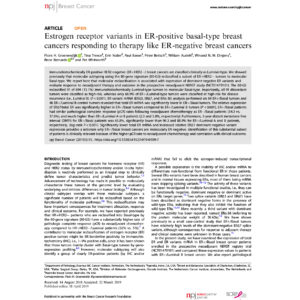PUBLICATION: 
npj Breast Cancer; volume 5, Article number: 15 (2019).
AUTHORS:
Floris H. Groenendijk, Tina Treece, Erin Yoder, Paul Baron, Peter Beitsch, William Audeh, Winand N. M. Dinjens, Rene Bernards & Pat Whitworth
ABSTRACT:
Immunohistochemically ER-positive HER2-negative (ER+HER2−) breast cancers are classified clinically as Luminal-type. We showed previously that molecular subtyping using the 80-gene signature (80-GS) reclassified a subset of ER+HER2− tumors to molecular Basal-type. We report here that molecular reclassification is associated with expression of dominant-negative ER variants and evaluate response to neoadjuvant therapy and outcome in the prospective neoadjuvant NBRST study (NCT01479101). The 80-GS reclassified 91 of 694 (13.1%) immunohistochemically Luminal-type tumors to molecular Basal-type. Importantly, all 91 discordant tumors were classified as high-risk, whereas only 66.9% of ER+/Luminal-type tumors were classified at high-risk for disease recurrence (i.e., Luminal B) (P < 0.001). ER variant mRNA (ER∆3, ER∆7, and ERα-36) analysis performed on 84 ER+/Basal tumors and 48 ER+/Luminal B control tumors revealed that total ER mRNA was significantly lower in ER+/Basal tumors. The relative expression of ER∆7/total ER was significantly higher in ER+/Basal tumors compared to ER+/Luminal B tumors (P < 0.001). ER+/Basal patients had similar pathological complete response (pCR) rates following neoadjuvant chemotherapy as ER−/Basal patients (34.3 vs. 37.6%), and much higher than ER+/Luminal A or B patients (2.3 and 5.8%, respectively). Furthermore, 3-year distant metastasis-free interval (DMFI) for ER+/Basal patients was 65.8%, significantly lower than 96.3 and 88.9% for ER+/Luminal A and B patients, respectively, (log-rank P < 0.001). Significantly lower total ER mRNA and increased relative ER∆7 dominant-negative variant expression provides a rationale why ER+/Basal breast cancers are molecularly ER-negative. Identification of this substantial subset of patients is clinically relevant because of the higher pCR rate to neoadjuvant chemotherapy and correlation with clinical outcome.
Read more: Groenendijk_2019_npj Breast Cancer_ERpos Basal

